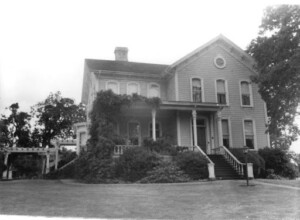Bush House
Built in 1878, the Bush House served as the home of one of Salem’s leading citizens, Asahel Bush, who founded both the Oregon Statesman newspaper and Ladd & Bush Bank. The Bush property remained in private, family ownership until the 1940s, except for some acreage deeded to the city as public parkland in 1917.
The spacious Bush estate, with its house, barn, outbuildings and gardens, is now operated as a public park and forms the hub and major portion of the historic district. The centerpiece of the Gaiety Hill/Bush’s Pasture Park Historic District is the 100-acre public park known as Bush’s Pasture Park. For the past thirty-seven years the City of Salem and the Salem Art Association have operated a cultural complex in the midst of this vast area of preserved natural beauty.
In 1860, Asahel Bush II, prominent pioneer newspaper publisher and banker, purchased the 100 acres from Dr. David Leslie, the pioneer Methodist missionary who held the original donation land claim, for $4,000. From 1877 to 1878, he built an impressive Italianate structure, designed by Wilbur F. Boothby, which was home to the Bush family for the next seventy-five years. The home was the focal point of a farm complex which included a large barn, a much-loved and used greenhouse, various gardens and orchards, and open ground for pasturing cattle.
In the late 1940s, the City of Salem acquired the land from two of Mr. Bush’s children, A. N. and Sally Bush. When Mr. Bush first acquired the land, it was outside the city limits but as the years passed it became a central portion of the growing City of Salem. The estate was coveted land and the Bushes were offered a high price from a Seattle developer who planned to demolish the house and subdivide the land. The Bush family preferred to sell the estate to the City for a much lower price. They specified that the area be named “Bush’s Pasture Park” in honor of their father.
The Bush House, operated since 1953 by the Salem Art Association, is open to the public. A historic house museum, it features the original furnishings, wallpapers, and gas lights as well as ten fireplaces carved of Italian marble. The Bush House was listed on the National Register of Historic Places in 1974.
The family barn, rebuilt after a fire in 1963, is now the Bush Barn Art Center, featuring exhibits and sales galleries, classrooms for community art classes, and a pottery studio.
The conservatory, built by Mr. Bush for his daughters in 1882, is now the oldest greenhouse in Oregon and is filled with period plants, maintained by volunteers.
During the third weekend of July the park blooms with art and entertainment during the annual Salem Art Fair and Festival, one of the largest and best art fairs in the Northwest.
Bush House and Bush Barn, the conservatory, the rose gardens, the winding paths through the tall oak trees, the bubbling creek where the Kalapuya Indians camped and collected camas; today all of this remains as a preserved part of Salem’s past. It is a part of the fabric of Salem life and is a source of great pride to the community.
Researched and written by Paul Porter and Susan Gibby.
This article originally appeared on the original Salem Online History site and has not been updated since 2006.








Leave A Comment